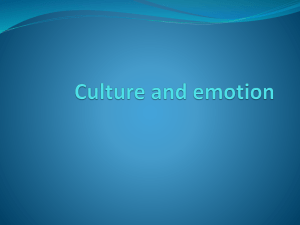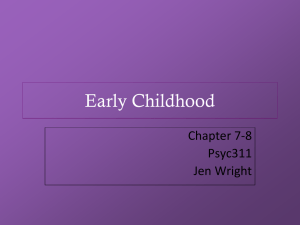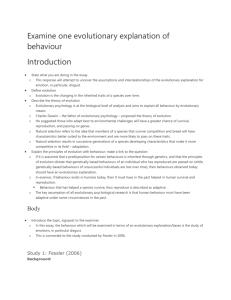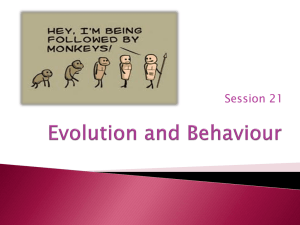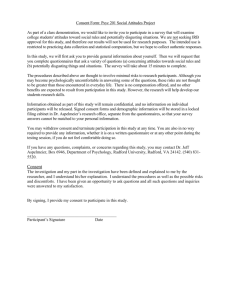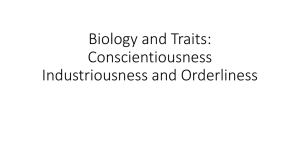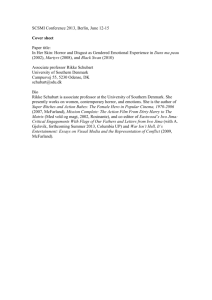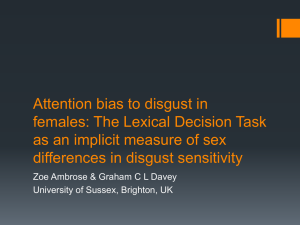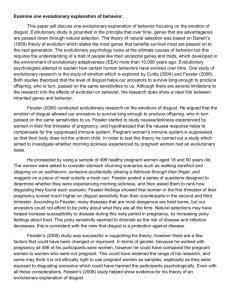View article - New York University
advertisement
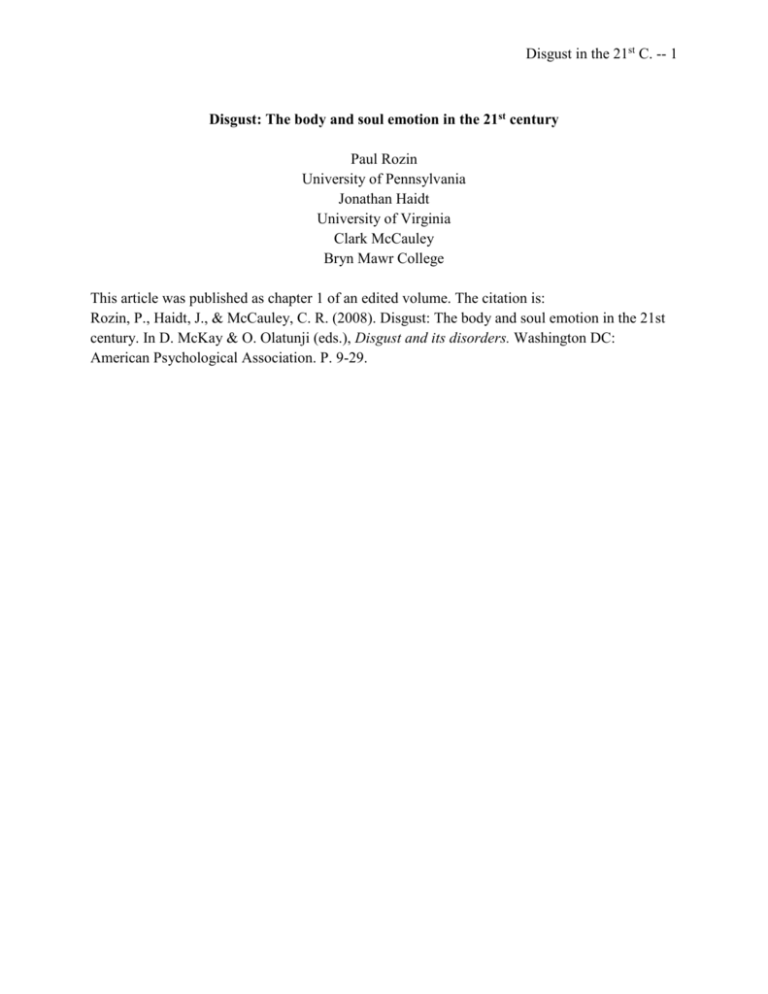
Disgust in the 21st C. -- 1 Disgust: The body and soul emotion in the 21st century Paul Rozin University of Pennsylvania Jonathan Haidt University of Virginia Clark McCauley Bryn Mawr College This article was published as chapter 1 of an edited volume. The citation is: Rozin, P., Haidt, J., & McCauley, C. R. (2008). Disgust: The body and soul emotion in the 21st century. In D. McKay & O. Olatunji (eds.), Disgust and its disorders. Washington DC: American Psychological Association. P. 9-29. Disgust in the 21st C. -- 2 Disgust: The body and soul emotion in the 21st century The present volume is, we believe, the first-ever edited volume devoted to the emotion of disgust. In this chapter we address the following issues: 1. Why was disgust almost completely ignored until about 1990, 2. Why has there been a great increase in attention to disgust since about 1990?, 3. The outline of an integrative, body-to-soul preadaptation theory of disgust, 4. Some specific features of disgust that make it particularly susceptible to laboratory research and particularly appropriate to address some fundamental issues in psychology. In the final section, we outline some new questions that arise from the recent increased interest in disgust in the areas of brain mechanisms, psychopathology, the psychometric approach to the structure of disgust, and disgust and morality. We then indicate some important aspects of disgust that have yet to receive systematic investigation. Why the delay? A Century of Ignoring Disgust Disgust got off to a good start in Charles Darwin’s classic, The expression of the emotions in man and animals (1998/1872). Darwin listed disgust as one of 32 emotions and made it an important component of Chapter 11, “Disdain – Contempt – Disgust – Guilt – Pride, etc.” He even included a page with drawings of disgust expressions. As emotion research developed within psychology, however, disgust (and most of the other emotions mentioned by Darwin) dropped out of the picture. Attention converged on sadness, anger and fear (and only recently on happiness as well). Thus, in William James’ (1890) classic chapter on emotion, the word disgust (disgusted/disgusting) is mentioned 3 times, in comparison to anger/angry (20 times, plus 11 for “rage”), and fear/afraid/fright (42 mentions). We examined the indices of 15 major introductory psychology textbooks from 1890 to 1958 (The titles of these texts, a convenience sample of the texts available in the University of Pennsylvania library, are listed in the notes to Table 2, p. 368, of Rozin, 2006) indicates a total of 5 page references to disgust, as opposed to 46 for anger and 85 for fear. This lack of interest in disgust is surprising because disgust meets the standard criteria for being a basic emotion as well as any other candidate, according to the criteria set forth by Ekman (1992), and it is usually included in lists of basic emotions, which typically also include anger, fear, happiness, sadness, and surprise. The landmark books on emotion (Izard, 1977; Lazarus, 1991; Plutchick, 1980; Tomkins, 1963), give considerable attention to disgust, and there is one classic paper (Angyal, 1941). But, as a topic for either research or attention in the teaching of psychology, disgust was almost absent during the 20th century. This absence in the more recent literature was documented by Olatunji and Sawchuk (2005), who carried out a search for anger, fear, and disgust on the PsycInfo reference data base from 1960 to 2003. There were virtually no papers on disgust until the 1990s. There is no simple explanation for this neglect but four factors may have contributed. First, all human endeavors, starting with perception/attention, involve information overload and filtering out most of the input. Limited cognitive resources for humans and limited Disgust in the 21st C. -- 3 human resources for research in academic psychology virtually require a selection of a small subset of possible topics for study and attention (Rozin, 2007a). So, of Darwin’s 32 candidate emotions, it is not surprising that only a few became the targets for major research programs. Second, fear is easy to see and study in other animals, and is obviously fundamental in many forms of psychopathology. Anger as a source of violence has clear relevance to social problems. So it is not surprising that fear and anger receive much more attention than disgust. As already noted, from William James onward, psychologists have focused on fear and anger in trying to understand both everyday problems and pathologies. A search of two linguistic data bases (from the Linguistic Data Consortium [www.ldc.upenn.edu]--a very large compendium of English language news sources, and a more modest base of spoken English sampled from transcriptions of telephone conversations--reveals the following. In the news database, there were 17,663 citations to disgust (disgust, disgusted, disgusting), compared to 177,018 for anger/angry, and 285,194 for fear/afraid. That is, relative to disgust, citations to anger were 10 times more common and citations to fear were 16 times more common. In the conversation data base, however, the ratios were 1.4 to 1 for anger and 7 to 1 for fear. These lower ratios suggest that in common speech disgust is relatively more frequent than in writing. A third reason may be that disgust, as its name suggests, is particularly associated with food and eating. Psychologists have sought general mechanisms of behavior rather than focusing on specific domains of life (Rozin, 2006), and the food domain, in particular, has received very little attention (Rozin, 2006. 2007). A fourth reason for disgust avoidance may simply be that disgust is disgusting. Pelham, Mirenberg, and Jones (2002) demonstrated that tiny flashes of affective positivity influence people to choose marriage partners and careers whose names resemble their own (e.g., men named Lawrence are more likely than average to become lawyers and marry women named Laurie). It seems likely, therefore, that when graduate students choose research topics, many are steered away from the revolting subject matter of disgust. Thus psychologists’ weak attention to disgust may be a result of some combination of the following factors: disgust was lost in Darwin’s long list of emotions; disgust lost out to fear and anger in the race to be relevant to human problems; disgust was seen as relevant to only that narrow part of human behavior related to food and eating; and disgust research is avoided as disgust is avoided. Why Now?: Documenting the Rise of Interest in Disgust The analysis by Olatunji and Sawchuk (2005) indicates a notable rise in disgust citations in the 1990s, stabilizing at around 50 a year in the last decade. Compared to levels of about 500 for anger and 1200 for fear, the level is still modest but the increase is impressive. In this time period, disgust seems to have assumed the place that would be accorded to it in terms of its relative frequency in English-language news sources although still well below the level of English-language conversations (both estimated from the Linguistic Data Consortium, see above, www.ldc,upenn.edu), Disgust in the 21st C. -- 4 We are not aware of any academically oriented books on disgust before 1997, but, since the publication of William Ian Miller’s (1997) The Anatomy of Disgust, there has been at least one other book focused on disgust (S. Miller, 2004), and two well-regarded psychology trade books with prominent attention to disgust (Bloom, 2004; Pinker, 1997). Interest in the involvement of disgust in anxiety disorders (particularly phobias and obsessive compulsive disorders) was signaled by special issues devoted to disgust in the Journal of Anxiety Disorders (McKay, 2002) and the Journal of Behavior Therapy and Experimental Psychiatry (Olatunji & McKay, 2006). We recently coded all 139 abstracts in the PsycInfo database that mentioned disgust in the title, abstract, or key phrase from 2001-2006. Our analysis showed that the largest focus of recent work is the link between disgust and psychopathology (primarily but not entirely phobias and OCD; 37% of references), followed by neurological/neuroanatomical/neurochemical aspects of disgust (18% of references). None of the remaining topics had seven or more percent of the references. Some of the more common of these smaller categories were the psychometrics and structure of disgust, contamination and odor, dynamics of disgust (especially moment to moment changes and interactions with other emotions), moral disgust, psychophysiology, development, and expression. The body-to-soul preadaptation theory of disgust One reason for the recent explosion of interest in disgust may be the growing recognition that disgust is related to many social, cultural, and even spiritual issues. In 1993 we developed a theory of disgust to explain how this originally food-related emotion expanded, both in biological and in cultural evolution, to become a guardian of the body, the social order, and the soul (the body-to-soul preadaptation theory). We began with the recognition that disgust was at its core a food rejection emotion (Rozin & Fallon, 1987), but that, cross culturally, disgust elicitors come from a wide variety of domains. We suggested that foods and body products are the core disgust elicitors, the elicitors for which the brain was most directly shaped by natural selection, probably in order to avoid biological pathogens (Rozin & Fallon,1987, Rozin et al., 1993, 1997). In our view, this powerful core disgust system, which stimulates a sense of repulsion and a withdrawal from the elicitor, was preadapted for easy extension to other threatening entities, including social and moral threats. Making something disgusting means producing internalized motivation to avoid it. What is done with feces in toilet training can be done with other things, including inappropriate sex, poor hygiene, violations of the body envelope (e.g., the stump from an amputated hand, or viscera exposed by a wound), and death. Although many of these avoidances may have some health benefits, the justification that people are aware of is often more symbolic. Large families of disgust elicitors are features that humans share with animals: eating/food, excreting, sex, soft body interiors, and death. The authors formulated this entire set of elicitors as reminders of our animal nature. In this view, humans display, in most cultures, a strong desire to be seen as qualitatively distinct from other animals, to be “more than animals.” Disgust is in the service of this desire by causing us to recoil from reminders of our animal nature. Disgust in the 21st C. -- 5 Perhaps the most threatening characteristic that humans share with other animals is mortality, and avoidance of contact with death, either physically or mentally, seems to be central to disgust. The quintessential odor of disgust, the putrid odor, is the odor of decaying animal flesh. Our linking of disgust and death, inspired in part by Ernst Becker’s (1973) Denial of Death, paralleled the development of terror management theory (TMT) in social psychology (Greenberg, Pyszczynski, & Solomon, 1986; Solomon, Greenberg, & Pyszczynski, 1991). TMT, also rooted in Becker’s ideas, highlights the importance of commitment to cultural norms as a defense against individual mortality. Direct linkages between mortality salience and disgust have been established (Cox et al., 2006; Goldenberg et al., 2001). Our further analysis suggested two other domains of disgust elicitors, not related to our animal nature. One is interpersonal disgust: disgust at other persons, particularly strangers and out-groups. A second is moral disgust, in which disgust is harnessed to produce offense at certain culturally determined moral violations. In terms of Shweder’s cross-cultural taxonomy of moral systems (community, autonomy, and divinity; Shweder et al., 1997), disgust seems to be the emotion linked to violations of divinity (the CAD triad hypothesis, Rozin et al., 1999b). Haidt and his colleagues have demonstrated that disgust plays a direct role in many moral judgments (Haidt, 2001; Haidt, Koller & Dias, 1993; Wheatley & Haidt, 2005). Disgust is now a part of moral psychology. What (Else) Makes Disgust (Suddenly) so Interesting? Disgust has a number of special properties that might account for its recent and rapid rise as an object of interdisciplinary study. It also has a few properties that ought to motivate more research in the future. 1. Convenience. Psychologists have understandably tried to bring their research into the laboratory, to establish more control and allow for experimentation. One of the challenges of emotion research is that, ethically, it is difficult to elicit strong emotions in the laboratory. In particular, it is ethically problematic to elicit fear or anger in a realistic way in the laboratory. It is relatively easy, however, to stimulate disgust in the laboratory—even in an fMRI scanner--and this can be done in ethically acceptable and ecologically valid ways. One can present real disgust elicitors, in photograph or in reality (e.g., a cockroach) and produce strong disgust in participants. We have done this using over 20 different real elicitors (Rozin et al., 1999a). 2. Contamination. Contamination is a special property of disgust elicitors; they have the power to render a good food inedible by mere brief contact (Rozin, Millman & Nemeroff, 1986). Examples of contamination seem to follow the sympathetic magical law of contagion: “Once in contact, always in contact.” Sensitivity to contagion appears to be present in all adult humans, but absent in children (see Fallon, Rozin, & Pliner, 1984; reviewed in Rozin & Nemeroff, 1990). Contamination effects, for which disgusting entities are particularly good elicitors, are of interest to researchers in judgment and decision making, because the effects are very powerful and often “irrational. It is important to recognize that contagion effects using disgust elicitors are not directly mediated (in contemporary humans) by a fear of infection. Although individuals typically Disgust in the 21st C. -- 6 justify their rejection of a juice contacted by a cockroach in terms of health risks, their aversion is not reduced significantly if the cockroach is sterilized (Rozin et al., 1986). Contamination effects connect disgust research with work on essentialism in developmental psychology, and likewise with the study of obsessive compulsive disorder. 3. The disgust scale. The availability of a tool often stimulates research and makes what the tool measures more salient; this seems to have happened for disgust. The Disgust Scale (Haidt, McCauley, & Rozin, 1994) has become a widely used instrument, and because it was designed to investigate many subtypes of disgust, rather than providing an overall score, it has stimulated discussion of the structure of disgust, and of the relationships between subtypes of disgust and specific mental disorders (Olatunji et al., in press). (Information about the Disgust Scale is available at: www.people.virginia.edu/~jdh6n/disgustscale.html ) 4. Affective neuroscience. Two important neuroscience findings launched an extensive exploration of disgust and the brain, motivated in part by the rapid development of brainscanning methodologies. Sprengelmeyer et al. (1996) made the remarkable finding that individuals with Huntington’s disease, a hereditary but late onset disorder principally of the motor system, showed a surprisingly specific deficit in recognizing disgust faces. Along with work on fear and the amygdala, this was one of the first findings suggesting that different emotions might have different mediating brain loci, in humans. The presence of this deficit in carriers of Huntington’s disease, who do not yet show the late onset motor symptoms, is particularly striking (Gray et al., 1997). An extensive series of brain scanning studies arose at about the same time, starting with the work of Phillips (Phillips et al., 1997). These studies showed that some brain areas-particularly the anterior insula, some basal ganglia structures, and some parts of the frontal cortex--are specifically involved in the experience of disgust. This work connects disgust research with one of the most rapidly growing areas in psychology—neuroscience--where the ease of eliciting disgust in a realistic way has great appeal. Neuroscience research promises both to enlighten us about the brain mechanisms of disgust and to provide tests of some psychological ideas about disgust--for example, whether all types of disgust are linked in the brain to a food/taste/smell system, and whether moral disgust shares circuitry with core disgust. 5. Anxiety disorders. The central role of disgust in some anxiety disorders was suggested by Davey and his collaborators (Matchett & Davey, 1991; Davey, 1993), when they pointed out that disgust is an important and previously ignored aspect of phobias. In addition, their diseaseavoidance interpretation of disgust elicitors provided a conceptual link between research on disgust and research on phobias. The disgust-phobia link is now a major line of research, followed up by Davey and his group, and Woody and Teachman (2000), among others. Power and Dagliesh (1997) have emphasized this and other links between disgust and psychopathology. Disgust is also known to be central to obsessive-compulsive disorder (OCD). The link is substantively clear, at least for the case of the contamination variety of OCD, which seems to relate to both enhanced disgust and enhanced contamination sensitivity. The disgust-OCD link appeared in print from a number of different sources in the period of 1999-2001, and a whole set Disgust in the 21st C. -- 7 of studies relating disgust sensitivity to clinical OCD, or to OCD tendencies, are now in the literature (reviewed by Berle & Phillips, 2006; Husted, Shapira, & Goodman, 2006; and Olatunji & Sawchuk, 2005). 6. Public interest. Although psychology has not been driven, to a major degree, by what the public finds interesting (Rozin, 2006), public interest may have some effect, and disgust is of interest to many people. Media interest in research on disgust has been high, and popular television programs like “Fear Factor” speak to its appeal. The Future of Disgust Research Disgust has, until recently, been a hole in emotion research. As a hole fills, sub-holes are often created (Rozin, 2007). Currently, brain research and psychopathology are the two enthusiasms that are filling in parts of the disgust hole, and leaving sub-holes. We review here some some research directions we think are promising that have yet to receive significant attention. The first two areas (brain mechanisms and psychopathology) are well developed, but we indicate some possible lines of work within these areas that have yet to be explored. The remaining areas have received little or no attention. 1) Brain mechanisms We expect to see many more brain scan studies indicating activation of brain areas during the elicitation or expression of disgust, and of contamination as well. These, plus analyses of disgust deficits resulting from brain damage, can be expected to provide more details of the brain circuits that may be dedicated to disgust, and also test some psychological claims. For example, it should be possible, as studies have already suggested (Moll et al., 2005), to indicate the degree of shared and distinct circuitry for core versus moral, or other varieties of disgust. Brain scan studies are also likely to shed light on the relations among disgust and related emotions, such as contempt, anger, shame, and fear. Evidence that Huntington carriers have a severe deficit in disgust recognition (Sprengelmeyer et al., 1996; Gray et al, 1997) points to potentially exciting psychological studies. These unfortunate individuals may allow us to study what it is like to grow up in an environment in which the most prominent signal of disgust (the face of others) is not processed. If disgust is the emotion of civilization, what are the consequences for a Huntington carrier? 2) Disgust and psychopathology Similarly, we expect to see many more studies of the relation between OCD and phobias, on one hand, and disgust and contamination sensitivity on the other. The mixture of fear and disgust in many phobias needs attention (Davey, 1993) and is getting, further elaboration (Davey, 1993). Contamination sensitivity is part of the disgust scale (Haidt et al., 1994), and correlates with sensitivity to the domain-specific areas of disgust, and all eight of the original components of the Disgust Scale correlate with measures of OCD tendencies (Olatunji et al., 2005, 2007). Conceptually, however, we can separate three factors: how disgusting something is, the extent to which it is transmitted by contact (contagion potential), and the indelibility of this transfer (related to spiritual vs. material essence (Nemeroff & Rozin, 1994). It is possible, but not necessary, that OCD involves high levels of all three of these factors. Disgust in the 21st C. -- 8 In addition, there have been suggestions of the involvement of disgust in a wide range of disorders beyond OCD and phobias, so there is likely more in store about disgust and psychopathology (Davey et al., 1998; Power & Dagliesh, 1997; Schienle et al., 2003). 3) Disgust, animal reminders, and death Our designation of animal nature reminders as a domain of disgust, between core disgust and social and moral disgust, is a theoretical claim. It has received some empirical support from studies on the psychometric structure of disgust (Olatunji et al., in press), but it needs refinement and more evidence. Of particular interest is the link between death and disgust. In Becker’s (1973) scheme, in which mortality is the basic human dilemma (as opposed to Freud’s emphasis on sex and aggression) disgust becomes a mechanism of denial or repression, as disgust causes withdrawal from thoughts about, or contact with, death. Terror management theory, currently a very productive line of empirical research, will no doubt make many more contacts with the study of disgust. 4) Development of disgust and contamination We presume that toilet training is an early and important disgust experience, in cultures that have toilet training. It seems that with the rejection of psychoanalysis, a baby or two may have been thrown out with the bathwater. There is minimal work in psychology now on either toilet training or weaning, two of Freud’s favorite developmental issues (Rozin, 2006). Since feces is probably the universal primal disgust, toilet training is a valuable arena in which to study the acquisition of disgust. The conversion of feces from a desired to a detested and disgusting substance is a major transformation that could be a model system for the study of the acquisition of strong affect of many kinds, including social emotions of shame, guilt, and embarrassment. The spread of disgust from feces to other body products, foods of animal origin, and eventually other entities presents a fascinating developmental problem. Does the acquisition of disgust follow in any way the sequence we have proposed for the cultural evolution of disgust? To what extent are disgusts acquired secondarily (Rozin & Fallon, 1987) by generalization from already disgusting entities (see Ferenczi, 1914/1952)? To what extent are disgusts generated by pairing with disgust faces or other indicators of offense? Can the acquisition of disgust sensitivities be understood as a form of evaluative conditioning? We presume that basic disgust socialization begins in parent-child or sib-child interactions, but this has not been studied. Today we have only a few studies showing a modest level of family (parent-child) resemblance in disgust sensitivity (Davey, Forster, & Mayhew, 1991; Rozin, Fallon, & Mandell, 1984). Contamination sensitivity is not present in children below the age of about four (Fallon, Rozin & Pliner, 1984; Siegal, 1988). If, as we have suggested, contamination sensitivity is necessary, then disgust does not appear in full until about this age. All indications are that the contamination response (to feces and many other disgusts, depending on the culture) is universal among adults, and universally absent in young children and all animals. How is the idea of “once in contact, always in contact” acquired? Does it depend, for example, on cognitions about the action of invisible entities, like germs (Rosen & Rozin, 1993)? Disgust in the 21st C. -- 9 To what extent is the development of disgust and contamination different in different cultures? Does it relate, for example, to the manner and severity of toilet training? We have a little cross-cultural evidence suggesting similarity in contagion sensitivity in American and Hindu Indian children in the preschool to early school years, but with contagion sensitivity appearing somewhat earlier in Indian children, and with a greater focus on interpersonal contagion in the Indian children (Hejmadi, Rozin, & Siegal, 2004). These questions have so far attracted relatively little research attention. . 5) Disgust in human history Disgust, as we have defined it, including contamination and ideational (as opposed to sensory) food rejection, is uniquely human. The cognitive sophistication required to react to the nature or history of an object appears only in humans older than three or four. Of course, a disgust progenitor, a rejection system with appropriate expressions for bad tasting foods (e.g. mouth gape in response to bitter taste), exists in many mammals and in human infants. Nevertheless, and despite its obvious biological significance, disgust may be the last of the “basic” emotions to have emerged in human evolution. We have no idea when in history ideational rejections of foods (based on their nature or origin, rather than sensory properties) arose. Disgust is clearly part (though not all) of the particular food taboos found in ancient Hinduism and Judaism. In Western European history, especially around eating and the table, disgust played a role in many of the changes in manners and mores during the thousand plus years that have been well chronicled (Elias, 1939/1978; Kass, 1994; Miller, 1997). There are two events in Western European history that have special relevance for the cultural evolution of disgust. One is the acceptance of Darwin’s theory of evolution by natural selection. The pre-Darwinian mentality (Thomas, 1963) with respect, for example, to human relations to animals, was quite different than the view that emerged in the 50 to 100 years after the publication of the Origin of Species in 1859. Animal-nature disgust might well have changed considerably as thinking about animals changed. The second major event, less than half a century after Darwin’s Origin, is the rise of germ theory. Germ theory provides a scientific basis for the contagion ideas that preceded it by thousands of years. Scientific demonstration of potent invisible entities is likely to have had a significant impact on lay thinking about contamination and disgust. A particularly illuminating examination of this possibility was carried out by Barnes (2006), who studied the public and medical professional reactions to sewage backups in Paris (“the great stinks of Paris”) in the middle and late 19th century. The major great stink of Paris occurred just as germ theory was taking root in France. The “sanitary-bacteriological-synthesis,” or the “marriage of filth and germs,” is described by Barnes as a fascinating convergence of intuition-based attitudes to illness and death with the scientific advances associated with germ theory. So far as we are aware, the history of disgust and contamination in East Asian, South Asian, African, and Amerindian cultures is unexplored territory. 6) Disgust in relation to other emotions Disgust in the 21st C. -- 10 Among emotions, disgust is perhaps closest to contempt. Tomkins (1963) and Miller (1997) have had much of interest to say about these two emotions. Tomkins links contempt more to smell, and disgust more to taste, and Miller conceives of contempt as more linked to pride, superiority, and indifference than disgust. These suggestions fit with the CAD hypothesis that disgust is the moral emotion associated with violation of the ethic of divinity, whereas contempt is the emotion associated with violation of the ethic of community (including hierarchy and respect; Rozin et al., 1999b). Disgust and shame are another pair of related emotions. In one perspective, disgust is an other-directed moral emotion, and shame a similar but more self-directed emotion. Finally, there seem to be relationships between disgust and hatred that must be worked out (see discussions in Tomkins, 1963 and Miller, 1997). In general, the relation of disgust with other social emotions is yet to be explored. 7) Intergroup disgust Disgust may play an important role in inter-group relations. Dehumanization seems to be involved in very negative attitudes to, harsh treatment of, and even genocide directed at particular groups (Chirot & McCauley, 2006). Haslam (2006) distinguishes between animalistic dehumanization that makes the enemy more like animals, and mechanistic dehumanization that makes the enemy less human by denying them uniquely human characteristics that makes them more like a machine. Haslam suggests that disgust is the emotional reaction associated with animalistic dehumanization. Similarly, Des Pres (1976) suggested that an important support for Nazis killing Jews and other inmates in concentration camps was the animal dehumanization imposed upon them by the living conditions they were subjected to. Nazis found it easier to kill animals than humans. According to DesPres, those prisoners who resisted “animalization” (e.g., by washing themselves even with muddy water) were more likely to survive. Fiske, Cuddy, Glick, and Xu (2002) have suggested that groups perceived as lower in status and dissimilar to the reference group tend to be viewed by the reference group with disgust and contempt. Related results suggest that disgust sensitivity is positively correlated with negative attitudes to foreigners, immigrants, out-groups, and deviant individuals (Faulkner, Schaller, & Park, 2004; Hodson & Costello, 2007; Navarette & Fessler, 2006). This relation may be mediated by fear of infection or contamination (Faulkner et al., 2004; Navarette & Fessler, 2006). Thus, in the context of intergroup relations, disgust may serve as both a response to a threat of contamination and a justification for hostility that can extend to mass murder. 8) Disgust, morality, and the way culture shapes disgust Disgust has stimulated research and thinking about morality in two ways. It has provided another dimension in our understanding of emotion and morality, moving beyond the usual focus on anger. Thus, by a process of moralization, certain activities that were once morally neutral or even status-positive (like cigarette smoking) become morally negative (Rozin, 1997). When this occurs in body-related domains, there is reason to believe that disgust is recruited as an Disgust in the 21st C. -- 11 emotional response, as for example in reaction to cigarettes, cigarette ashes, and even smokers (Rozin and Singh, 1999). Second, studies related to disgust have contributed to debate about the relative role of rationality and affect or emotion in moral judgment. It is no accident that the major presentation of the intuitionist position in moral psychology (Haidt, 2001) came from a psychologist whose interest in moral judgment originated in research on disgust (Haidt, Koller, & Dias, 1993). As Haidt suggests that affect leads moral judgment, so it may be possible that affect leads political opinions. Pizarro et al. (2007) found that political conservatives score higher in disgust sensitivity. Future research might examine individual differences in disgust sensitivity within cultures as a partial account of differences in political ideology.. 9) The structure of the domains of disgust There is much yet to learn about the linkage between the various domains of disgust. Our preadaptive account provides one among a possible set of taxonomies. Psychometric research such as the work of Olatunji (Olatunji et al., in press) promises to help us to carve the categories of disgust at their joints. Work on psychophysiology and brain activation or lesions will help us to see what disgust elicitors share common mechanisms. 10) Contamination Work by Carol Nemeroff (Nemeroff and Rozin, 1994) identifies two models of contagion, at least for Americans. In one model, material essence, the source of contagion behaves like a microscopic particle. It can be eliminated by washing, sterilization or some other physical procedure. In the other model, spiritual essence, the essence seems to be permanent and indestructible. For most people, you can’t get Adolph Hitler out of his sweater (spiritual essence). For many of those same people, you can with some difficulty get the hepatitis out of a sweater worn by someone with that disease (material essence). The cognitions and feelings behind these two types of contagion, usually linked to disgust, need to be understood, as well as the causes of between- and within-culture differences in the properties of essence, and the type of essence that is assumed to be transmitted by contact with disgusting or other negative entities. A particularly important feature of contagion, paralleled by disgust, is the journey from the physical to the moral. Though moral contagion is often indelible, it is sometimes treated as if it is physical. A very promising line of research recently demonstrated the effectiveness, for Americans, of washing, a physical cleansing operation, as a way of ridding the self of moral contamination (Zhong & Liljenquist, 2006). 11) Unmaking disgust We live in a disgusting, contaminated world. Almost everything we interact with--chairs, doorknobs, air, food--has been in contact with other human beings. This could be crippling, but people come to terms with it (unless they have OCD, contamination type) by a combination of habituation, reframing, and retreating to ritual and sacred law. We do not know the dynamics of how this occurs, but it is obvious that we ignore many potential disgust elicitors in daily life, unless called to our attention. Door knobs, for instance, tend to escape our attention except Disgust in the 21st C. -- 12 when, for example, an unsavory looking person handles a doorknob while exiting a public bathroom as we are about to reach for the same doorknob. Habituation must surely play a major role, and one critical issue is how specific the habituation is. This issue is especially salient for professions in which disgust elicitors are salient: surgeons, morticians, and individuals who deal with garbage. We recently showed what looks like habituation to the disgust eliciting properties of cadavers in medical students who spend months dissecting a cadaver, but this appears quite specific to death disgust elicitors, and perhaps does not even extend to still warm dead bodies (Rozin, 2008). Contamination sensitive religions, particularly Hinduism and Judaism, have ritual ways of dealing with contamination, including washing and establishing acceptable thresholds for contamination (e.g., the 1/60th rule for contamination in the rules of Kashrut [Grunfeld, 1982; Nemeroff & Rozin, 1987]). It is easy to imagine experimental investigations of habituation to disgust. How often would an undergraduate need to experience putting a pin in the eye of a refrigerated sheep’s head, for instance, in order to find this experience more boring than disgusting? How long would habituation endure after the last trial? What cultural differences might appear in habituation experiments? Happily experiments of this kind are unlikely to attract the concern of Institutional Review Boards. Much needs to be done to understand how human beings in different cultures deal with the fact that they live in a contaminated world. 12) Disgust and holes Disgust centers around the holes in the body. Most of the most disgusting body products (e.g., feces, vomit) emanate from holes, and the holes are also foci for disgust sensitivity. There has been minimal work on the holes in the body, perhaps part of the general reaction formation to Freudian conceptions (Rozin, 2006, 2007). But holes, especially Freud’s “big three” (mouth, anus, and genitals) have too much to do with disgust to be ignored. They can be viewed as the most vulnerable gateways between the self and the body, between inside and outside; likewise they can be seen as guardians of the body, protectors from the possibility of physical contamination (Fessler & Haley, 2006; Miller, 1997; Miller, 2004; Rozin et al., 1995). 13) The dynamics of disgust Disgust, like other emotions, unfolds in a matter of seconds. Appraisals, expressions, behaviors, and physiological events, all occur in this period and influence one another. Scherer & Wallbott (1994) have provided a general framework for understanding the pattern of events across a number of emotions, including disgust. And recent psychophysiological studies begin to give a sense of the sequence of physiological components of disgust (Levenson, 1992; Stark et al., 2005). Still, we know relatively little about the time course of the multiple aspects of the experience of disgust. Finally, there is the issue of how disgust may interact with other emotions, either in alternation or blending. The close interplay and sequencing of different emotional states is a general problem for researchers interested in emotions (e.g., Marzillier & Davey, 2005). 14) The biological and cultural evolution of disgust Disgust in the 21st C. -- 13 One of the fundamental aspects of understanding anything in psychology is to understand the degree to which it has evolutionary origins, and if so, what they are. Disgust came on the stage of psychology, in part, through the writings of Darwin (1872/1998). In its anlagen (origin form), not part of disgust now as we conceive it, it is clearly an adaptive mechanism to rid the body of potentially harmful foods or odors, and perhaps, to communicate information about this to conspecifics. Furthermore, a number of investigators have proposed, with evidence that the disgust and contamination responses originated as adaptive responses to the prospect of microbial infection (Davey, 1993; Curtis & Biran, 2001; Curtis, Aunger & Rabie, 2004; Fessler & Haley, 2006; Faulkner et al., 2004). Fessler (e.g., Fessler & Haley, 2006) and Schaller (e.g., Schaller & Neuberg, 2007) have been particularly active in promoting evolutionary insights into disgust and contagion. One of the most interesting problems that remains is to see how cultural evolutionary mechanisms, like preadpatation, have built upon a basic disgust/contamination system, and expanded it to a point where its origin is often totally disguised. It is also possible that there are evolved predispositions to find certain things (e.g., perhaps feces) disgusting, and that disgust provides a promising arena for understanding interactions between biological and cultural evolution. 15) Humor We close with an unusual and appropriately amusing aspect of disgust. Disgust is often funny. It is a major part of the humor of young boys, and has its own genre of jokes (Fine, 1988; Miller, 1997). It seems, that just like chili pepper, roller coaster rides, and horror movies, disgust is enjoyable because it elicits a negative emotion or feeling, but in an environment in which cognitions indicate there is no real threat (Rozin, 1990; Rozin & Schiller, 1980; McCauley, 1998). Participants in studies on disgust often laugh and show signs of amusement (Hemenover & Schimmack, in press; Rozin et al., 1999a). We have called this benign masochism. It plays a substantial role in human life, including in the experience of disgust. Benign masochism seems to depend on a competition between an emotion of the body and an emotion of civilization; the civilized mind seems to take pleasure in the fact that it can rise above its animal instincts. Conclusion Many have observed that a good piece of research raises more questions than it answers. The first decade or two of intensive research on disgust has raised more questions than it has answered. In our view, the biggest one is how a mouth and food oriented rejection mechanism, a “get this out of my body” emotion, has been elaborated (culturally and biologically) into a broad and meaning-rich emotion that protects not just the body, but the soul. This book will serve to set an agenda for the next decade; there is much to do. Disgust in the 21st C. -- 14 References Angyal, A. (1941). Disgust and related aversions. Journal of Abnormal and Social Psychology, 36, 393-412. Barnes, D. S. (2006). The great stink of Paris and the marriage of filth and germs. Baltimore: Johns Hopkins University Press. Becker, E. (1973). The denial of death. New York: Free Press. Berle, D., & Phillips, E. S. (2006). Disgust and Obsessive-Compulsive Disorder. An Update. Psychiatry, 69, 228-238. Bloom, P. (2004). Descartes’ baby. How the science of child development explains what makes us human. New York: Basic Books. Chirot, D., & McCauley, C. (2006). Why not kill all of them? The logic and prevention of mass political murder. Princeton, NJ: Princeton University Press Cox, C. R., Goldenberg, J. L., Pyszczynski, T., & Weise, D. (in press). Disgust, creatureliness and the accessibility of death-related thoughts. European Journal of Social Psychology. Curtis, V., Aunger, R., & Rabie, T. (2004). Evidence that disgust evolved to protect from risk of disease. Proceedings of the Royal Society B. (Suppl) 271, S131-S133. Curtis, V., & Biran, A. (2001). Dirt, disgust, and disease. Is hygiene in our genes? Perspectives in Biology and Medicine, 44, 17-31 Darwin, C. R. (1998). The expression of the emotions in man and animals. Definitive edition. Oxford, U.K. Oxford University Press (original work published 1872. Davey, G. C. L. (1993). Factors influencing self-rated fear to a novel animal. Cognition & Emotion, 7, 461-471. Davey, G. C. L., Buckland, G., Tantow, B., & Dallos, R. (1998). Disgust and eating disorders. European Eating Disorders Review, 6, 201-211. Davey, G. C. L., Forster, L., & Mayhew, G. (1991). Familial resemblance in disgust sensitivity and animal phobias. Behaviour Research & Therapy, 31, 41-50. Des Pres, T. (1976). The survivor. An anatomy of life in the death camps. Oxford, U.K.: Oxford University Press. Ekman, P. (1992). An argument for basic emotions. Cognition and Emotion, 6, 169-200. Elias, N. (1978). The history of manners: Vol. 1. The civilizing process (E. Jephcott, Trans.). New York: Pantheon Books. (Original work published 1939). Fallon, A. E., Rozin, P., & Pliner, P. (1984). The child's conception of food: The development of food rejections with special reference to disgust and contamination sensitivity. Child Development, 55, 566-575. Faulkner, J., Schaller, M., Park, J. H., & Duncan, L. A. (2004). Evolved Disease-Avoidance Mechanisms and Contemporary Xenophobic Attitudes. Group Processes and Intergroup Relations, 7, 333-353. Ferenczi, S. (1952). The ontogenesis of the interest in money. In S. Ferenczi (Ed.), First contributions to psychoanalysis (E. Jones, Trans.) (pp. 319-331). London: Hogarth Press. (Original work published 1914) Disgust in the 21st C. -- 15 Fessler, D. M. T., & Haley, K. J. (2006). Guarding the perimeter: The outside-inside dichotomy in disgust and bodily experience. Cognition and Emotion, 20, 3-19. Fine, G. A. (1988). Good children and dirty play. Play & Culture, 1, 43-56. Fiske, S. T., Cuddy, A. J. C., Glick, P., & Xu, J. (2002). A model of (often mixed) stereotype content: Competence and warmth. Journal of Personality and Social Psychology, 82, 878-902. Goldenberg, J. L., Pyszczynski, T., Greenberg, J., Solomon, S., Kluck, B., & Cornwell, R. (2001). I am not an animal: Mortality salience, disgust, and the denial of human creatureliness. Journal of Experimental Psychology: General, 130, 427-435. Gray J. M., Young, A.W., Barker W.A., Curtis A., & Gibson, D. (1997). Impaired recognition of disgust in Huntington’s disease gene carriers. Brain, 1120, 2029– 38. Greenberg, J., Pyszczynski, T., & Solomon, S. (1986). The causes and consequences of a need for self-esteem: a terror management theory. In R. F. Baumeister (Ed.), Public self and private self (pp.189-212). New York: Springer-Verlag. Grunfeld, D. I. (1982). The Jewish dietary laws: Vol. 1. Dietary laws regarding forbidden and permitted foods, with particular reference to meat and meat products (3rd Ed.). London: Soncino Press. Haidt, J. (2001). The emotional dog and its rational tail: A social intuitionist approach to moral judgment. Psychological Review, 108, 814-834. Haidt, J., Koller, S., & Dias, M. (1993). Affect, culture, and morality, or is it wrong to eat your dog? Journal of Personality and Social Psychology, 65, 613-628. Haidt, J., McCauley, C. R., & Rozin, P. (1994). A scale to measure disgust sensitivity. Personality and Individual Differences, 16, 701-713. Haslam, N. (2006). Dehumanization: An integrative review. Personality and Social Psychology Review, 10, 252-264. Hejmadi, A., Rozin, P., & Siegal, M. (2004). Once in Contact, Always in Contact: Contagious Essence and Conceptions of Purification in American and Hindu Indian Children. Developmental Psychology, 40, 467-476. Hemenover, S. H., & Schimmack, U. (in press). That’s disgusting!...But very amusing: Mixed feelings of amusement and disgust. Cognition and Emotion. Hodson, G., & Costello, K. (2007). Interpersonal disgust, Ideological orientations and dehumanization as predictors of intergroup attitudes. Psychological Science, 18, 691698.. Husted, D. S; Shapira, N. A., & Goodman, W. K. (2006). The neurocircuitry of obsessivecompulsive disorder and disgust. Progress in NeuroPsychopharmacology and Biological Psychiatry,. 30, 389-399. Izard, C. E. (1977). Human Emotions. New York: Plenum Press. James, W. (1950). The principles of psychology. New York: Dover.(Original work published 1890). Kass, L. (1994). The hungry soul. New York: Free Press. Disgust in the 21st C. -- 16 Lazarus, R. S. (1991). Emotion and adaptation. New York: Oxford University Press. Levenson, R. W. (1992). Autonomic nervous system differences among emotions. Psychological Science, 3, 23-27. Linguistic Data Consortium. www.ldc.upenn.edu. Marzillier, S. L., & Davey, G. C. L. (2005). Anxiety and disgust: Evidence for a unidirectional relationship. Cognition and Emotion, 19, 729-750. Matchett, G., & Davey, G. C. L. (1991). A test of a disease-avoidance model of animal phobias. Behaviour Research & Therapy, 29, 91-94. McCauley, C. (1998). When screen violence is not attractive. In J. Goldstein (Ed.), Why we watch: The attractions of violent entertainment, pp. 144-162. New York: Oxford University Press McKay, D. (2002). Introduction to the special issue: The role of disgust in anxiety disorders. Journal of Anxiety Disorders, 16, 475-476. Miller, S. B. (2004). Disgust. The gatekeeper emotion. Hillsdale, N. J.; The Analytic Press. Miller, W. I. (1997). The anatomy of disgust. Cambridge, Massachusetts: Harvard University Press. Moll, J., deOliveira-Souza, R., Moll, F.T., Ignacio, F.A., Bramati, I. E., Caparelli, D.E. M., Eslinger, P.J. (2005). The Moral Affiliations of Disgust: A Functional MRI Study. Cognitive and Behavioral Neurology, 8, 68-78. Navarette, C. D., & Fessler, D. M. T. (2006). Disease avoidance and ethnocentrism: the effects of disease vulnerability and disgust sensitivity on intergroup attitudes. Evolution and Human Behavior, 27, 270-282. Nemeroff, C., & Rozin, P. (1987). Sympathetic magic in kosher practice and belief at the limits of the law of Kashrut. Jewish Folklore & Ethnology Review, 9, 31-32. Nemeroff, C., & Rozin, P. (1992). Sympathetic magical beliefs and kosher dietary practice: The interaction of rules and feelings. Ethos: The Journal of Psychological Anthropology, 20, 96-115. Nemeroff, C., & Rozin, P. (1994). The contagion concept in adult thinking in the United States: Transmission of germs and interpersonal influence. Ethos: The Journal of Psychological Anthropology, 22, 158-186. Olatunji, B. O., Lohr, J. M., Sawchuk, C. N., & Tolin, D. F. (2007). Multimodal assessment of disgust in contamination-related obsessive-compulsive disorder. Behaviour Research and Therapy, 45, 263-276. Olatunji, B., & McKay, D. (2006). Introduction to the special series: Disgust sensitivity in anxiety disorders. Journal of Behavior Therapy and Experimental Psychiatry, 37, 1-3. Olatunji, B. O. & Sawchuk, C. N. (2005). Disgust: Characteristic features, social manifestations, and clinical implications. Journal of Social and Clinical Psychology, 24, 932-962. Olatunji, B. O., Williams, N. L., Lohr, J. M., & Sawchuk, C. N. (2005). The structure of disgust: Domain specificity in relation to contamination ideation and excessive washing. Behaviour Research and Therapy, 43, 1069-1086. Disgust in the 21st C. -- 17 Olatunji, B. O., Williams, N. L., Tolin, D. F., Sawchuck, C. N., Abramowitz, J. S., Lohr, J. M., et al. (in press). The disgust scale: Item analysis, factor structure, and suggestions for refinement. Psychological Assessment. Pelham, B. W., Mirenberg, M. C., & Jones, J. K. (2002). Why Susie sells seashells by the seashore: Implicit egotism and major life decisions. Journal of Personality and Social Psychology, 82, 469-487. Phillips, M. L. et al. (1997). A specific neural substrate for perceiving facial expressions of disgust. Nature, 389, 495-498. Pinker, S. (1997). How the mind works. New York: W. W. Norton. Pizarro, D., & Bloom, P. (2007). Disgust sensitivity and political ideology. Unpublished manuscript, Cornell University. Plutchik, R. (1980). Emotion: A psychoevolutionary synthesis. New York: Harper & Row. Power, M., & Dalgleish, T. (1997). Cognition and Emotion: From order to disorder. East Sussex, UK: Psychology Press (Lawrence Erlbaum). Rosen, A., & Rozin, P. (1993). Now you see it....Now you don't: The preschool child's conception of invisible particles in the context of dissolving. Developmental Psychology, 29, 300-311. Rozin, P. (1990). Getting to like the burn of chili pepper: Biological, psychological and cultural perspectives. In B. G. Green, J. R. Mason & M. R. Kare (Eds.), Chemical senses, Volume 2: Irritation (pp. 231-269). New York: Marcel Dekker. Rozin, P. (1997). Moralization. In A. Brandt & P. Rozin (Eds.). Morality and health (pp. 379401) New York: Routledge. Rozin, P. (2006). Domain denigration and process preference in academic psychology. Perspectives on Psychological Science, 1, 365-376. Rozin, P. (2007). Exploring the landscape of modern academic psychology: Finding and filling the holes. American Psychologist.62, 754-766. Rozin, P. (2008). Hedonic “adaptation”: Specific habituation to disgust/death elicitors as a result of dissecting a cadaver. Judgment and Decision Making (in press). Rozin, P., & Fallon, A. E. (1987). A perspective on disgust. Psychological Review, 94, 23-41. Rozin, P., Fallon, A. E., & Mandell, R. (1984). Family resemblance in attitudes to food. Developmental Psychology, 20, 309-314. Rozin, P., Haidt, J., & McCauley, C. R. (1999c). Disgust: The body and soul emotion. In T. Dalgleish & M. Power (eds.) Handbook of Cognition and Emotion (Pp. 429-445). Chichester, U. K.: John Wiley. Rozin, P., Haidt, J., & McCauley, C. R. (1993). Disgust. In M. Lewis & J. Haviland (eds.). Handbook of emotions (pp. 575-594). New York: Guilford. Rozin, P., Haidt, J., & McCauley, C. R. (2000). Disgust. In M. Lewis & J. Haviland (eds.). Handbook of emotions, second edition (pp. 637-653). New York: Guilford. Rozin, P., Haidt, J., McCauley, C. R., Dunlop, L., & Ashmore, M. (1999a). Individual differences in disgust sensitivity: Comparisons and evaluations of paper-and-pencil Disgust in the 21st C. -- 18 versus behavioral measures. Journal of Research in Personality, 33, 330-351. Rozin, P., Haidt, J., McCauley, C. R., & Imada, S. (1997). The cultural evolution of disgust. In H. M. Macbeth (ed.). Food preferences and taste: Continuity and change (pp. 65-82). Oxford, U.K.: Berghahn. Rozin, P., Lowery, L., Imada, S., & Haidt, J. (1999b). The CAD triad hypothesis: A mapping between three moral emotions (contempt, anger, disgust) and three moral codes (community, autonomy, divinity). Journal of Personality & Social Psychology, 76, 574586. Rozin, P., Markwith, M., & McCauley, C. R. (1994). The nature of aversion to indirect contact with other persons: AIDS aversion as a composite of aversion to strangers, infection, moral taint and misfortune. Journal of Abnormal Psychology, 103, 495-504. Rozin, P., Millman, L., & Nemeroff, C. (1986). Operation of the laws of sympathetic magic in disgust and other domains. Journal of Personality and Social Psychology, 50, 703-712. Rozin, P., & Nemeroff, C. J. (1990). The laws of sympathetic magic: A psychological analysis of similarity and contagion. In J. Stigler, G. Herdt, & R. A. Shweder (Eds.), Cultural psychology: Essays on comparative human development (pp. 205-232). Cambridge, England: Cambridge University Press. Rozin, P., Nemeroff, C., Horowitz, M., Gordon, B., & Voet, W. (1995). The borders of the self: Contamination sensitivity and potency of the mouth, other apertures and body parts. Journal of Research in Personality, 29, 318-340. Rozin, P., & Schiller, D. (1980). The nature and acquisition of a preference for chili pepper by humans. Motivation and Emotion, 4, 77-101. Rozin, P., & Singh, L. (1999). The moralization of cigarette smoking in America. Journal of Consumer Behavior, 8, 321-337. Schaller, M., & Neuberg, S. (2007). The nature in prejudice(s). Submitted manuscript Scherer, K. R., & Wallbott, H. G. (1994). Evidence for universality and cultural variation of differential emotion response patterning. Journal of Personality & Social Psychology, 66, 310-328. Schienle, A., Schafer, A., Stark, R., Walter, B., Franz, M., & Valtl, D. (2003). Disgust sensitivity in psychiatric disorders: A questionnaire study. Journal of Nervous and Mental Disease, 191, 831–834. Shweder, R. A., Much, N. C., Mahapatra, M., & Park, L. (1997). The "big three" of morality (autonomy, community, divinity), and the "big three" explanations of suffering. In: A. Brandt & P. Rozin (eds.). Morality and health. (pp. 119-169). New York: Routledge. Siegal, M. (1988). Children's knowledge of contagion and contamination as causes of illness. Child Development, 59, 1353-1359. Solomon, S., Greenberg, J., & Pyszczynski, T. (1991). A terror management theory of social behavior: The psychological functions of self-esteem and cultural worldviews. In M. P. Zanna (Ed.), Advances in Experimental Social Psychology: Vol. 24. (pp. 93-159) New York: Academic Press. Disgust in the 21st C. -- 19 Sprengelmeyer, R. Young, A.W., Calder ,A. J. Karnat, A., Lange, H., Homberg, V., et al. (1996). Loss of disgust: perception of faces and emotions in Huntington’s disease. Brain, 119, 1647-1665. Stark, R., Walter, B., Schienle, A., and Vaitl, D. (2005). Psychophysiological correlates of disgust and disgust sensitivity. Journal of Psychophysiology, 19, 50-60. Thomas, K. (1983). Man and the natural world. Changing attitudes in England 1500-800. London: Penguin. Tomkins, S. S. (1963). Affect, imagery, consciousness: Vol. 2. The negative affects. New York: Springer. Wheatley, T., & Haidt, J. (2005). Hypnotically induced disgust makes moral judgments more severe. Psychological Science, 16, 780-784 Woody, S. R., & Teachman, B. A. (2000). Intersection of disgust and fear: Normative and pathological views. Clinical Psychology: Science and Practice, 7, 291–311. Zhong, C-B., & Liljenquist, K. (2006). Washing away your sins: Threatened morality and physical cleansing. Science, 313, 1451-1452.
